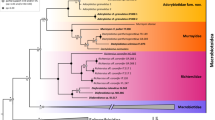Abstract
The morphology of the male terminalia (uncus and subunci) was studied in 39 species of the subtribe Polyommatina (Lycaenidae). Traces of nine established characters were mapped on the molecular phylogeny of the subtribe proposed by Talavera et al. (2013). The ancestral character states for these morphological structures were established in Plebejus s. l. and Polyommatus s. l. According to the time calibration of the proposed molecular tree, the studied skeletal structures (uncus and subunci) evolved very slowly within the last million years. It was shown that the similar shape of the uncus and subuncus branches arose independently and underwent parallel morphological transformations. In particular, wide and, as a rule, ventrally directed uncus lobes arose independently in Polyommatus s. str., Alpherakya, Glabroculus, and Aricia. Yet, in various evolutionary lines of Polyommatina similar changes in the length ratio of the proximal and distal parts of the subunci as well as in the shape of their apical hooks were observed. The character states marking the groups Polyommatus s. str. and Aricia were established. The evolutionary changes in the uncus morphology were highly non-uniform in the various monophyletic lines of Polyommatina. As a result, representatives of some “old” lines have more specialized features of the uncus morphology in comparison with those belonging to “young” lines that retain ancestral character states. In Polyommatina, the transformation of the male terminalia was directed toward development of the most effective mechanism of female fixation during copulation. This goal was reached in similar ways in various evolutionary lines of Polyommatina, which explains numerous parallelisms in morphology of these structures.
Similar content being viewed by others
References
Campbell, D.L., Brower, A.V.Z., and Pierce, N.E., “Molecular Evolution of the Wingless Gene and Its Implications for the Phylogenetic Placement of the Butterfly Family Riodinidae (Lepidoptera: Papilionoidea),” Molecular Biology and Evolution 17 (5), 684–696 (2000).
Coutsis, J.G., “The Male Genitalia of N American Icaricia lupini and I. acmon; How They Differ from Each Other and How They Compare to Those of the Other Two Members of the Group, I. neurona and I. shasta (Lepidoptera: Lycaenidae, Polyommatiti),” Phegea 39 (4), 144–151 (2010).
Eliot, J.N., “The Higher Classification of the Lycaenidae (Lepidoptera): a Tentative Arrangement,” Bulletin of the British Museum (Natural History), Entomology 28 (6), 371–505 (1973).
Heikkilä, M., Mutanen, M., Wahlberg, N., Sihvonen, P., and Kaila, L., “Elusive Ditrysian Phylogeny: an Account of Combining Systematized Morphology with Molecular Data (Lepidoptera),” BMC Evolutionary Biology 15: 260 (2015).
Kandul, N.P., Lukhtanov, V.A., Dantchenko, A.V., Coleman, J.W.S., Sekercioglu, C.H., Haig, D., and Pierce, N.E., “Phylogeny of Agrodiaetus Hübner 1822 (Lepidoptera: Lycaenidae) Inferred from mtDNA Sequences of COI and COII and Nuclear Sequences of EF1-a: Karyotype Diversification and Species Radiation,” Systematic Biology 53 (2), 278–298 (2004).
Korzeev, A.I. and Stekolnikov, A.A., “Congruence between Comparative Morphology and Molecular Phylogenies: the Final Stage of Evolution of the Skeletal Characters of Male Genitalia in the Subtribe Polyommatina (Lepidoptera, Lycaenidae). Part 1. Valvae (Distal Part), Aedeagus, and Juxta,” Entomologicheskoe Obozrenie 95 (3), 473–503 (2016) [Entomological Review 96 (6), 647–671 (2016)].
Kuznetzov, V.I., and Stekolnikov, A.A., New Approaches to the System of Lepidoptera of the World Fauna (Based on Abdominal Functional Morphology) (Nauka, St. Petersburg, 2001) [in Russian].
Megens, H.-J., Van Nes, W.J., Van Moorsel, C.H.M., Pierce, N.E., and De Jong, R., “Molecular Phylogeny of the Oriental Butterfly Genus Arhopala (Lycaenidae, Theclinae) Inferred from Mitochondrial and Nuclear Genes,” Systematic Entomology 29, 115–131 (2004).
Stekolnikov, A.A., “Evolution of the Skeleton and Musculature of the Male Genitalia in the Family Lycaenidae (Lepidoptera): II. Infratribe Polyommatina Swainson, 1827,” Entomologicheskoe Obozrenie 89 (3), 561–587 (2010) [Entomological Review 91 (1), 37–57 (2011)].
Stekolnikov, A.A., Lukhtanov, V.A., and Korzeev, A.I., “Congruence between Comparative Morphology and Molecular Phylogenies: Evolution of the Male Genital Skeletal/Muscular System in the Subtribe Polyommatina (Lepidoptera, Lycaenidae),” Entomologicheskoe Obozrenie 92 (3), 517–535 (2013) [Entomological Review 94 (2), 166–180 (2014)].
Stradomsky, B.V., “Taxonomy of Lycaenidae (Lepidoptera: Papilionoidea) of Southern Russia: Molecular Genetic and Morphological Aspects,” Kavkazskii Entomologicheskii Byulleten 10 (1), 121–128 (2014).
Stradomsky, B.V., “Molecular Phylogeny of the Subfamily Polyommatinae (Lepidoptera: Lycaenidae),” Kavkazskii Entomologicheskii Byulleten 12 (1), 145–156 (2016).
Talavera, G., Lukhtanov, V.A., Pierce, N.E., and Vila, R., “Establishing Criteria for Higher-Level Classification Using Molecular Data: The Systematics of Polyommatus Blue Butterflies (Lepidoptera, Lycaenidae),” Cladistics 29, 166–192 (2013) (doi 10.1111/j.1096–0031.2012.00421.x).
Van Dorp, K., “Molecular Systematic of Lycaena F., 1807 (Lepidoptera: Lycaenidae)—Some Preliminary Results,” Proceedings of the Netherlands Entomological Society Meeting 15, 65–70 (2004).
Vila, R., Bell, Ch.D., Macniven, R., Goldman-Huertas, B., Ree, R.H., Marshall, Ch.R., Bálint, Z., Johnson, K., Benyamini, D., and Pierce, N.E., “Phylogeny and Palaeoecology of Polyommatus Blue Butterflies Show Beringia was a Climate-Regulated Gateway to the New World,” Proceedings of the Royal Society B: Biological Sciences 278, 2737–2744 (2011).
Vodolazhsky, D.I. and Stradomsky, B.V., “A Phylogenetic Study of the Subgenus Polyommatus (s. str.) Latreille, 1804 (Lepidoptera: Lycaenidae) Using mtDNA Markers. Part I,” Kavkazskii Entomologicheskii Byulleten 10 (1), 123–130 (2008).
Wahlberg, N., Braby, M.F., Brower, A.V.Z., de Jong, R., Lee, M.-M., Nylin, S., Pierce, N.E., Sperling, F.A.H., Vila, R., Warren, A.D., and Zakharov, E., “Synergistic Effects of Combining Morphological and Molecular Data in Resolving the Phylogeny of Butterflies and Skippers,” Proceedings of the Royal Society B: Biological Sciences 272, 1577–1586 (2005).
Wiemers, M., Stradomsky, B.V., and Vodolazhsky, D.I., “A Molecular Phylogeny of Polyommatus s. str. and Plebicula Based on Mitochondrial COI and Nuclear ITS2 Sequences (Lepidoptera: Lycaenidae),” European Journal of Entomology 107, 325–336 (2010).
Zhdanko, A.B., “A Revision of the Supraspecific Taxa of the Lycaenid Tribe Polyommatini (Lepidoptera, Lycaenidae),” Entomologicheskoe Obozrenie 83 (3), 645–663 (2004) [Entomological Review 84 (7), 782–796 (2004)].
Author information
Authors and Affiliations
Corresponding author
Additional information
This article was originally submitted by the authors in Russian and is first published in translation.
Rights and permissions
About this article
Cite this article
Korzeev, A.I., Stekolnikov, A.A. Congruence between comparative morphology and molecular phylogenies: the final stage of evolution of the skeletal characters of male genitalia in the subtribe Polyommatina (Lepidoptera, Lycaenidae). Part 2. Uncus and subunci. Entmol. Rev. 97, 1031–1047 (2017). https://doi.org/10.1134/S0013873817080024
Received:
Published:
Issue Date:
DOI: https://doi.org/10.1134/S0013873817080024



